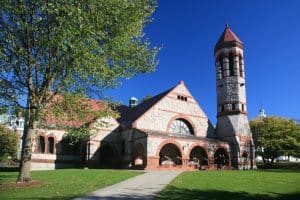Dartmouth Waitlist for 2025
Being put on a college waitlist can be a confusing and stressful experience. In some cases, you might feel a flicker of hope knowing you were not outright rejected. Yet in others, you endure an agonizing uncertainty, awaiting news that could dramatically shape your future. Dartmouth, a prestigious Ivy League institution, is no exception to this phenomenon. The Dartmouth waitlist can be a puzzling concept for many, so this article aims to offer a comprehensive overview of it.
Understanding the Dartmouth Waitlist Process
The first step towards grappling with the uncertainty of the waitlist is understanding how it works. The waitlist is initially a pool of applicants that the Admissions Committee felt were strong candidates but did not have room for in the incoming class. These applicants are offered a place on the waitlist, which effectively puts them in a state of limbo.
If a spot in the incoming class becomes open, Dartmouth will refer to the waitlist to fill it. The specific manner in which students are chosen from the waitlist to claim a spot can vary by institution, and Dartmouth’s specific policy is not made public knowledge.
However, it is worth noting that the waitlist process is not a guarantee of admission. It is important for waitlisted applicants to keep their options open and consider other schools they have been admitted to, as the chances of being accepted off the waitlist can be unpredictable.
The Role of the Waitlist in College Admissions
The waitlist plays a critical role in college admissions, serving as a buffer for schools to ensure they fill all open spots in their incoming class. In essence, the waitlist is a college’s insurance policy against under-enrollment. Filling every seat in an incoming class is crucial for a school’s budget and reputation.
This is particularly relevant at competitive schools like Dartmouth, where yield rates (the percentage of accepted students who choose to enroll) can be hard to predict. Thus, the waitlist provides a bank of qualified applicants that ensures Dartmouth has a full and vibrant class each year.
Moreover, the waitlist also serves as an opportunity for the Admissions Committee to reassess their needs and preferences. As the enrollment process unfolds, the committee may gain a clearer understanding of the composition of the incoming class and identify areas where they need to balance diversity, academic interests, or other factors. This information can influence the selection of students from the waitlist.
Key Factors Influencing the Dartmouth Waitlist
It’s important to keep in mind that many factors can influence how a waitlist is used in any given year. These variables include the size and strength of the early decision pool, the yield rate of admitted students, and even external factors such as the economy and changes in financial aid policies.
At Dartmouth, another factor is the institution’s policy on over-enrollment. Dartmouth historically enrolls more incoming students than its infrastructure can support, anticipating that a certain number will decline the offer of admission. This policy can often deeply impact the number of students pulled from the waitlist.
Additionally, the waitlist can also be influenced by the number of students who accept their spot on the waitlist and actively express their continued interest in attending Dartmouth. Demonstrating continued interest can play a role in the selection process, as it shows the Admissions Committee that the waitlisted applicant is still highly interested in attending Dartmouth if given the opportunity.
Overall, the Dartmouth waitlist process is a complex and dynamic system that takes into account various factors and considerations. While the specifics of how the waitlist is managed may not be publicly disclosed, understanding the role it plays in college admissions and the factors that influence it can provide valuable insights for waitlisted applicants.
The Numbers Behind the Dartmouth Waitlist
Data can provide useful insight into how Dartmouth’s waitlist operates. However, keep in mind that every admissions cycle is unique, so previous years’ figures should not be taken as definite predictors of the future.
Let’s dive deeper into the waitlist statistics for Dartmouth in the 2019-2020 admissions cycle. During this period, Dartmouth offered around 2,119 spots on the waitlist, giving hope to many applicants who were not initially admitted. Out of those on the waitlist, approximately 61 students were eventually admitted. That’s about a 2.88% acceptance rate from the waitlist, which is certainly slim. However, as a hopeful applicant, it’s important to remember that chances do exist.
It’s worth noting that these figures can vary from year to year. For instance, in the 2018-2019 admissions cycle, approximately 3.43% of waitlisted candidates were extended acceptances. This demonstrates that the number of students admitted from the waitlist can fluctuate depending on various factors. Mitigating factors such as yield rates of the early applicant pool impact how many waitlisted students are eventually admitted.
Comparing Dartmouth’s Waitlist to Other Ivy Leagues
When comparing Dartmouth’s waitlist acceptance rate to other Ivy League universities, it falls roughly around the middle. Each institution has its own unique strategy for managing its enrollment and leveraging its waitlist. For example, some institutions like Harvard and Columbia take very few students off the waitlist, making it highly competitive. On the other hand, institutions like Cornell and Penn provide more opportunities for waitlisted candidates, increasing the chances of being admitted.
Therefore, it’s important to understand that the statistical odds of being admitted from the waitlist are less important than what you do next. If you find yourself on Dartmouth’s waitlist, it’s crucial to take action and demonstrate your continued interest in the university. This can include submitting additional materials, such as updated grades or achievements, writing a letter of continued interest, or even visiting the campus if possible. These actions can help you stand out and increase your chances of being admitted from the waitlist.
Navigating the Dartmouth Waitlist
The waitlist might feel like purgatory, but it’s not a death sentence – there are actions you can take that could possibly influence your outcome.
When it comes to navigating the Dartmouth waitlist, there are several steps you can take to improve your chances of being admitted. It’s important to remember that being waitlisted means the admissions committee sees potential in you, so don’t lose hope just yet.
Steps to Take After Being Waitlisted
Firstly, you have the option to either accept or decline a spot on the waitlist. If Dartmouth is your top choice, it would be in your interest to accept the offer. By accepting, you are showing your continued interest in the school and keeping the door open for potential acceptance.
Once you have accepted a spot on the waitlist, it’s important to make sure Dartmouth knows that they are your top choice. Reach out to the admissions office and express your enthusiasm for the school. Let them know why Dartmouth is the perfect fit for you and how you can contribute to the campus community.
In addition to expressing your continued interest, it’s also a good idea to provide any significant updates to your application. This could include recent achievements, improved grades, or additional letters of recommendation. By keeping the admissions office informed about your accomplishments, you are showing them that you are a strong candidate who is constantly striving for excellence.
However, it’s important to check with Dartmouth’s Admissions Office on their policy regarding updates of this nature. Some schools may have specific guidelines on what type of updates they accept and how they should be submitted. Make sure you follow their instructions carefully to ensure your updates are considered.
Communicating with Dartmouth Admissions
When communicating with Dartmouth’s Admissions Office, it’s key to maintain a respectful and sincere tone. Remember that admissions officers are people, too, and appreciate considerate communication.
When reaching out to the admissions office, be sure to address them by their proper title and use a polite and professional tone. Thank them for considering your application and express your continued interest in the school. By showing your respect and appreciation, you are more likely to leave a positive impression.
It’s also important to understand that being persistent doesn’t mean being incessant. While updating the admissions office about your spring grades and major accomplishments can be beneficial, bombarding them with frequent, less significant updates might be seen as bothersome and could work against you. Use your judgment and only provide updates that are truly meaningful and impactful.
Remember, the waitlist process can be unpredictable, and there are no guarantees. However, by taking these steps and staying proactive, you are giving yourself the best possible chance of being admitted off the waitlist. Keep your head up, stay positive, and continue to pursue your academic and personal goals. Good luck!
The Impact of COVID-19 on the Dartmouth Waitlist
The global pandemic has inevitably affected every facet of life, and the Dartmouth waitlist process is no exception. As students and universities adapt to the challenges brought about by COVID-19, the dynamics of the waitlist have undergone significant changes.
Changes in Dartmouth’s Waitlist Trends Due to the Pandemic
In the wake of COVID-19, the flux of students deferring admission has potentially impacted Dartmouth’s waitlist. The College reported a surge in deferrals during the 2020-2021 admissions cycle, which could cause a domino effect influencing the number of students admitted off the waitlist in 2024 and possibly 2025.
With the uncertainty surrounding the pandemic and its long-term effects on higher education, many students have chosen to defer their enrollment to Dartmouth. This decision stems from various factors, including concerns about remote learning, limited campus experiences, and the desire to wait for a more traditional college experience. As a result, the waitlist pool has become more competitive, with a higher number of qualified candidates vying for a limited number of spots.
Furthermore, the pandemic has disrupted the traditional college admissions process, leading to changes in the way universities evaluate applicants. Dartmouth, like many other institutions, has had to rely heavily on virtual interviews, online portfolios, and test-optional policies. This shift in evaluation methods may have influenced the composition of the waitlist as admissions officers navigate through a different set of criteria to make their decisions.
Predictions for the Dartmouth Waitlist in 2025
Given the fact that we are navigating unprecedented times, predictions can only be speculative. Will Dartmouth’s class of 2025 see more or fewer students admitted off the waitlist than in previous years? The truth is that the pandemic’s impact on college admissions is still a developing story.
However, it is worth noting that Dartmouth, renowned for its exceptional academic programs and vibrant campus community, continues to attract a high number of qualified applicants each year. The college’s commitment to providing a transformative educational experience remains unwavering, even in the face of adversity. As the world gradually recovers from the pandemic, it is plausible to anticipate a return to a more traditional admissions process in the near future.
Regardless, maintaining a positive attitude and proactive mindset is key during these uncertain times. Students on the waitlist should continue to pursue their academic and personal goals while remaining open to alternative opportunities. Dartmouth, known for its holistic approach to admissions, values resilience, adaptability, and intellectual curiosity. These qualities will undoubtedly play a significant role in the final decisions made by the admissions committee.
The impact of COVID-19 on the Dartmouth waitlist cannot be understated. The pandemic has introduced a level of unpredictability and complexity to the admissions process, making it even more challenging for both applicants and the university. However, Dartmouth’s commitment to excellence and its dedication to shaping the next generation of leaders remain steadfast, ensuring that the waitlist experience continues to be a crucial part of the College’s admissions journey.
Tips for Prospective Students on the Dartmouth Waitlist
The Dartmouth waitlist might feel like an emotional roller coaster. Here are some tips to help navigate this process.
Maintaining Hope While on the Waitlist
It’s important not to lose hope while on the waitlist. The waitlist is not a rejection, and there is a realistic possibility of admission. While the odds might seem daunting, remember that the process is not completely out of your hands.
Continue to express your interest and keep Dartmouth updated with your accomplishments. A positive mindset can go a long way in this journey.
Preparing for Possible Acceptance from the Waitlist
While keeping hope alive, it’s essential to prepare for any outcome. If you’ve been waitlisted at Dartmouth, the most pragmatic strategy is to mentally prepare for enrolment at a different institution while still holding on to the possibility of a Dartmouth acceptance.
Final Thoughts
Being placed on Dartmouth’s waitlist means the admissions committee saw potential in you as a candidate. Whether or not you eventually get accepted, remember that your college journey will be a transformative experience, regardless of where you spend these formative years.
How AdmissionSight Can Help You with College Admissions
AdmissionSight is a college consulting firm that provides personalized assistance to students throughout the college admissions process. Here are some ways that AdmissionSight can help you:
Admissions strategy: AdmissionSight can help you develop a strategic plan for your college application process. Our professional consultants can assist with identifying schools that are a good fit for your academic, extracurricular, and personal goals and help you plan and prioritize your application strategy.
Application review: AdmissionSight can review your application and provide feedback on how to improve it. We can offer suggestions on making your application stand out and highlighting your strengths and unique qualities.
Essay coaching: AdmissionSight can help you craft compelling essays that showcase your personality, goals, and achievements. We can guide you through the essay writing process and provide feedback on your drafts to help you refine your writing.
Interview preparation: AdmissionSight can provide interview coaching to help you feel confident and prepared for college interviews. Our experts can offer tips on how to present yourself professionally and how to answer common interview questions.
Extracurricular planning: AdmissionSight can help you plan and develop your extracurricular activities to make them more impactful and meaningful. We can suggest activities that align with your interests and goals and provide guidance on demonstrating your leadership and initiative.
Overall, AdmissionSight can provide valuable guidance and support throughout the college admissions process to help you maximize your chances of getting accepted into the college of your choice.
With a high success rate of over 75%, we have built a strong network in the past decade. Book an initial consultation today, free of charge!









































